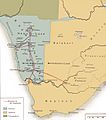German South-West Africa facts for kids
Quick facts for kids
German South West Africa
Deutsch-Südwestafrika
|
|||||||
|---|---|---|---|---|---|---|---|
| 1884–1915 | |||||||

Green: German South-West Africa
Dark Grey: Other German possessions Black: German Empire Note: The historical extent of German territories are depicted over present-day political borders. |
|||||||
| Status | German colony | ||||||
| Capital | Windhoek (from 1891) | ||||||
| Common languages | German (official), Herero, Afrikaans, Khoekhoe | ||||||
| Religion | Christianity, Saan religion | ||||||
| Governor | |||||||
|
• 1898–1905
|
Theodor von Leutwein | ||||||
|
• 1905–1907
|
Friedrich von Lindequist | ||||||
|
• 1907–1910
|
Bruno von Schuckmann | ||||||
|
• 1910–1915
|
Theodor Seitz | ||||||
| Historical era | Scramble for Africa | ||||||
|
• Established
|
7 August 1884 | ||||||
|
• Genocide
|
1904–1907 | ||||||
|
• Disestablished
|
9 July 1915 | ||||||
|
• Treaty of Versailles
|
1919 | ||||||
| Area | |||||||
| 835,100 km2 (322,400 sq mi) | |||||||
| Currency | German South West African mark | ||||||
|
|||||||
| Today part of | |||||||
German South West Africa (in German: Deutsch-Südwestafrika, often shortened to DSWA) was a land in Africa that was once a colony of Germany. This period lasted from 1884 until 1915. Today, this area is known as the country of Namibia.
From 1891, the main city and administrative center of German South West Africa was Windhoek. This city is still the capital of modern-day Namibia. The colony covered a very large area, about 835,100 square kilometers (322,434 square miles). This was more than one and a half times the size of Germany itself at that time.
Understanding German South West Africa
German South West Africa was part of a time called the "Scramble for Africa." During this period, many European countries tried to claim parts of Africa as their colonies. Germany wanted to expand its power and gain resources.
Why Germany Claimed This Land?
Germany became interested in this part of Africa in the late 1800s. They wanted to set up trading posts and gain control over valuable resources. They also wanted to show their strength as a new European power.
How the Colony Was Formed
The first German claims in the area began in 1883. A German merchant, Adolf Lüderitz, bought land near Angra Pequena (now Lüderitz Bay). Germany then officially declared the area a protectorate in 1884. This meant Germany would protect and control the land.
Life in the Colony
Life in German South West Africa was very different for the European settlers and the local African people. German was the official language, but local languages like Herero and Khoekhoe were also spoken. Christianity was introduced, though traditional Saan religions continued.
Who Governed the Colony?
The colony was ruled by governors sent from Germany. These governors were in charge of managing the land and its people. Some notable governors included Theodor von Leutwein and Theodor Seitz. They made decisions about laws, trade, and how the land was used.
Major Conflicts and Challenges
The period of German rule was not peaceful. There were many conflicts between the German authorities and the local African people. The local communities, like the Herero and Nama people, resisted German control.
A Difficult Period: 1904–1907
Between 1904 and 1907, there was a very sad and difficult time. Major conflicts broke out between the German forces and the Herero and Nama people. Many lives were lost during these uprisings. This period is remembered as a time of great suffering and loss for the indigenous people.
The End of German Rule
German South West Africa lasted for about 31 years. Its end came during World War I.
World War I and the Colony's Fate
When World War I began in 1914, South Africa, which was then part of the British Empire, invaded German South West Africa. The German forces in the colony were defeated in 1915. This marked the end of German control over the territory.
After the War: Treaty of Versailles
After World War I ended, the Treaty of Versailles was signed in 1919. This treaty officially took away all of Germany's colonies. German South West Africa was then placed under the control of South Africa. It remained under South African administration for many decades before finally gaining independence as Namibia in 1990.
Images for kids
See also
 In Spanish: África del Sudoeste Alemana para niños
In Spanish: África del Sudoeste Alemana para niños






